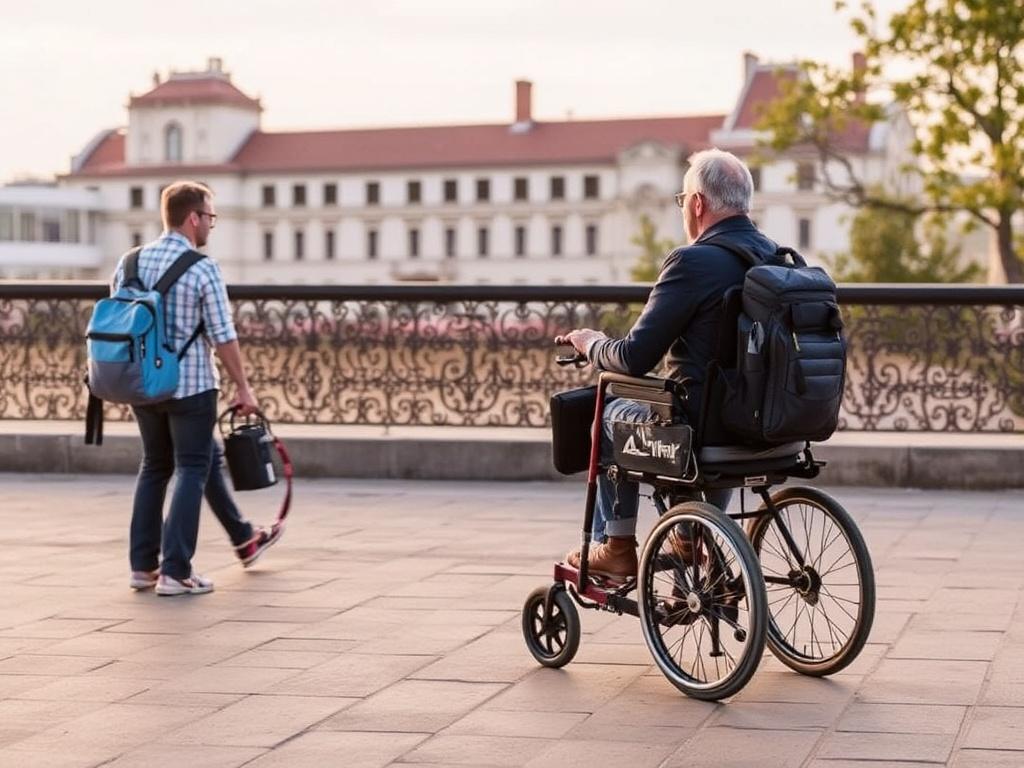
How to Travel with Limited Mobility: A Complete Guide to Stress-Free Adventures
Traveling can be one of the most rewarding experiences in life, but for those with limited mobility, it often comes with extra challenges. Whether you use a wheelchair, have difficulty walking long distances, or face other physical limitations, planning a trip can feel overwhelming. However, with the right knowledge and preparation, traveling with limited mobility is not only possible—it can also be enjoyable and fulfilling. This guide covers all the essential tips and tricks you’ll need to make your next adventure smooth and accessible.
Understanding Limited Mobility and Its Impact on Travel
Traveling with limited mobility means that a person might need some form of assistance or adaptive equipment to move around comfortably and safely. This can include the use of wheelchairs, walkers, or even just needing frequent breaks due to pain or fatigue. Recognizing your specific needs is the first step in planning a successful trip.
It’s important to remember that having limited mobility doesn’t mean you have to give up on travel dreams. Many destinations, transportation companies, and accommodation providers now offer services tailored for travelers with disabilities. The key is to know what to ask for and how to prepare so that your needs are met seamlessly.
Common Challenges Faced While Traveling with Limited Mobility
Traveling with physical limitations comes with challenges, but most of these can be anticipated and addressed with a bit of planning. Here are some common hurdles:
| Challenge | Description |
|---|---|
| Navigating Airports | Long distances, security checks, and busy terminals can be overwhelming and physically demanding. |
| Accessible Transportation | Finding taxis, buses, or rental cars equipped for wheelchairs or other aids. |
| Accommodation Accessibility | Ensuring hotel rooms have the necessary modifications such as ramps, grab bars, and wheelchair-accessible bathrooms. |
| Communication Barriers | Sometimes staff or locals might not be familiar with disability needs, causing misunderstandings. |
| Fatigue and Pain | Travel can increase discomfort or fatigue, requiring rest strategies and medication management. |
Planning Your Trip: Key Steps for Travelers with Limited Mobility
Preparation is the secret sauce to successful travel when you have limited mobility. Here are important steps to take before you embark on your journey:
1. Choose the Right Destination
Not every location is equally accessible, so picking a destination that suits your needs can make a huge difference. Some cities and countries excel in offering accessible public transportation, smooth sidewalks, and barrier-free sightseeing spots. Others may prove more challenging but still possible with the right support.
When researching destinations, look for:
- Availability of accessible attractions and tours
- Quality of healthcare facilities, just in case
- General layout of the city (flat terrain vs. hilly or uneven)
- Accessibility of public restrooms and services
2. Organize Accessible Transportation
Travel isn’t just about getting there—it’s about moving around once you arrive. Many airports now offer extensive assistance for passengers with limited mobility, but you’ll often need to request this service in advance. Airlines provide wheelchair assistance from check-in to boarding and upon arrival.
If you plan to use public transport or taxis at your destination, research ahead to find accessible options. Many cities have adapted buses with wheelchair lifts or low-floor boarding, and rideshare services sometimes offer accessible vehicle options.
3. Book Accommodation Carefully
Accessibility at your place of stay is crucial for comfort and independence. When booking a hotel, don’t just assume a “wheelchair accessible” label means what you need. Contact the hotel directly and inquire about:
- Width of doorways to fit your mobility device
- Bathroom features like roll-in showers and grab bars
- Elevator access and proximity of accessible rooms to amenities
- Parking availability and accessibility
Many hotels also provide mobility aids or have partnerships with local companies that rent equipment.
4. Pack Smart and Bring Essential Equipment
Packing for travel with limited mobility requires extra attention to what you might need daily. Apart from your mobility device, consider packing:
- Extra batteries or chargers for powered wheelchairs and scooters
- Medication and medical supplies, clearly labeled and in carry-on luggage
- Portable cushions or supports for long periods of sitting
- Comfortable, easy-to-remove clothing and shoes
- Adaptive utensils or tools if you need them
Always have a backup plan, like packing extra supplies in case delays occur.
Practical Tips for Traveling Through Airports
Airports can be intimidating, but with a little preparation, they don’t need to be stressful. Most major airports have services dedicated to helping passengers with limited mobility.
Request Assistance Early
Contact your airline at least 48 hours before your flight to request wheelchair assistance or other accommodations. This service often includes electric carts, help with baggage, and priority boarding. Airlines are required by law to provide reasonable accommodations, so don’t hesitate to ask.
Know Your Rights
In many countries, laws like the Air Carrier Access Act (ACAA) in the U.S. protect travelers with disabilities. These laws ensure airlines provide necessary assistance without extra charges.
Prepare for Security Screening
Security checkpoints may require extra time and may involve physical screening procedures. Inform TSA or security officers about your mobility devices; in many cases, they have protocols that can speed up the process and preserve the integrity of your equipment.
Airport Navigation Tips
- Arrive early to allow time for checks and transfers
- Use airport maps or apps to plan the easiest route to your gate
- Ask airport staff about accessible restrooms, lounges, and charging stations
Exploring Your Destination with Limited Mobility
Once you’ve landed, the adventure begins. Here are ways to maximize your experience while managing mobility limits.
Use Mobility-Friendly Tour Services
Many cities have tour operators specializing in accessible travel. These tours often provide adapted vehicles and trained guides who understand your needs. Taking a tour can relieve the stress of navigating unfamiliar areas alone.
Plan Rest Breaks and Pace Yourself
Travel can be physically demanding, so building in downtime is essential. Plan your sightseeing schedule to include regular breaks, especially if you experience fatigue or pain.
Research Local Culture and Attitudes
Cultural norms around disability vary worldwide. Some places may require a bit more patience or explanation when requesting accommodations or help. Learning a few phrases or carrying a card explaining your needs in the local language can be very useful.
Accessible Dining and Entertainment
Don’t forget about accessibility in restaurants and entertainment venues. Checking in advance if a place is wheelchair friendly, offers seating accommodations, or has accessible restrooms can save you frustration.
Helpful Technology and Apps for Travelers with Limited Mobility
Technology has made traveling far easier and more enjoyable for those with limited mobility. Here are some types of apps and gadgets that can help:
| App/Gadget | Purpose |
|---|---|
| Wheelmap | Finds wheelchair accessible places like restaurants, shops, and public transport. |
| Google Maps with Accessibility Info | Shows routes with fewer stairs and accessible transport options. |
| Handy Bible or Translator Apps | Communicate your needs in foreign languages. |
| Portable Battery Packs | Keep powered devices and mobility aids charged on the go. |
| Health Monitoring Apps | Track medication schedules, symptoms, and appointments. |
Exploring these can simplify many aspects of your journey and help you feel more confident and in control.
Travel Insurance Considerations for People with Limited Mobility
Travel insurance is important for everyone, but it’s especially critical for travelers with limited mobility. Here’s what to keep in mind:
- Ensure coverage includes pre-existing conditions and mobility aids
- Check for emergency evacuation services suited to your needs
- Look for trip interruption and cancellation protection
- Verify that coverage includes the possibility of medical care abroad
Disclose all health conditions and mobility requirements honestly when purchasing insurance. This helps avoid denied claims and ensures proper support if needed.
Tips for Traveling with a Companion or Caregiver
Sometimes traveling with limited mobility means having a companion or personal care assistant. Having the right person can make travel less stressful and more enjoyable.
Choose the Right Companion
Make sure your companion understands your needs, respects your independence, and communicates well with you. It’s important to feel comfortable sharing responsibilities and asking for help when necessary.
Plan Joint Activities
Collaborate when planning your itinerary to accommodate both your interests and your companion’s. This ensures everyone enjoys the trip.
Prepare for Shared Accommodations
Booking accommodations that suit both of you is important. Accessible rooms with extra space or adjoining rooms might work best depending on your preferences.
Common Myths About Traveling with Limited Mobility
Misconceptions about travel with disabilities can hold people back from exploring the world. Let’s bust some of the most common myths:
- Myth: Travel is too expensive if you have limited mobility.
Fact: Affordable travel is possible with proper planning, discounts, and accessible budget options. - Myth: You can’t visit major tourist attractions.
Fact: Many top sites worldwide are now accessible or offer accommodations. - Myth: Traveling solo isn’t safe for those with disabilities.
Fact: Solo travel is possible and empowering with the right preparation and precautions. - Myth: Assistance will always be unreliable.
Fact: While hiccups happen, most travel providers have trained staff and systems to help.
Overcoming these myths opens up a world of opportunities.
Resources for Travelers with Limited Mobility
Connecting with communities and organizations dedicated to accessible travel can be invaluable. Here are some useful resources:
- Accessible Travel Online – A hub for tips, reviews, and travel guides
- Passport to Access – Resources and stories from travelers with disabilities
- European Network for Accessible Tourism – Information on accessible destinations in Europe
- TSA Special Procedures – U.S. airport security info for travelers with disabilities
Joining online forums or groups on social media can also offer real-time advice and support.
Final Thoughts on Traveling with Limited Mobility
Conclusion
Traveling with limited mobility no longer needs to be a daunting or restrictive experience. Thanks to growing awareness, improved infrastructure, and advances in technology, the world is opening up to more inclusive travel opportunities. The key lies in detailed planning, advocating for your needs, and embracing the adventure with flexibility and a positive mindset. Whether it’s a city break, a nature escape, or an international journey, your dreams of discovery are within reach. The more you explore and prepare, the more you’ll find just how accessible and enriching travel with limited mobility can truly be. So pack your bags, make your plans, and get ready for a stress-free adventure tailor-made just for you.




